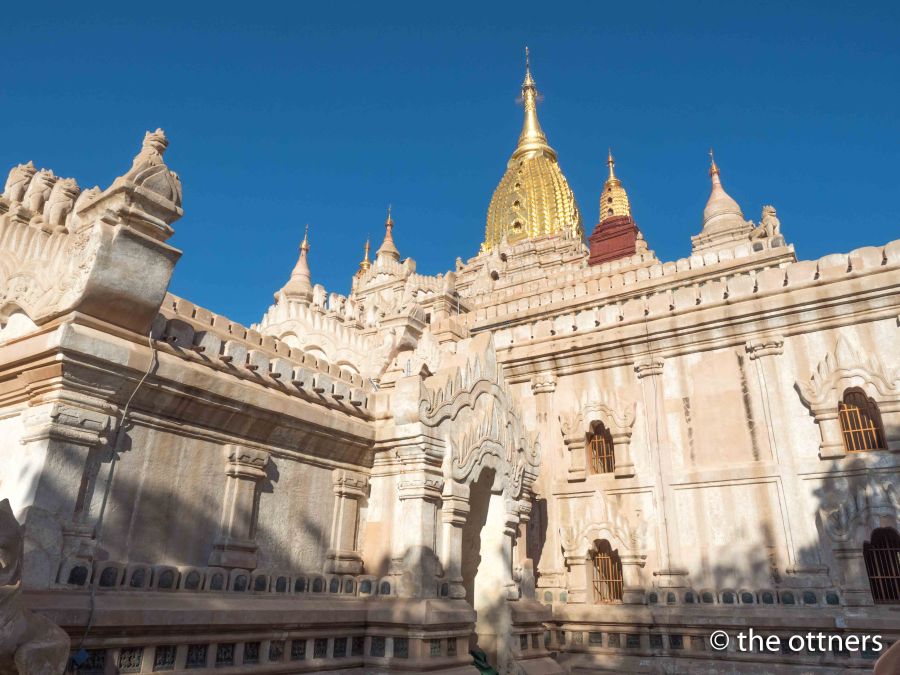Waking up earlier than I care for, the alarm started with a 4 … not a happy place but it would all be worth it as we were saying farewell to Yangon and hello to Bagan; the awe inspiring archaeological-site-meets-town where a series of over-enthusiastic kings thought they could buy their way into heaven by building thousands of temples.
Why the sudden love of temples? Well, Bagan was the place where Theravada Buddhism was first introduced to the Kingdom in the early eleventh century and despite centuries of neglect, incessant looting and earthquakes there are still over 2,000 left in “ruins” and easily accessible by car, bike or foot if you’re brave (silly) enough to endure the heat.
Unsurprisingly the wooden buildings from the eleventh century are long gone and the brick-and-stucco structures that do remain have been subject to some rather questionable restoration attempts but despite not being eligible for UNESCO World Heritage status this temple-studded plain is an amazing sight to see and can impressive even the most temple weary traveller.
After what was the quickest check-in to take-off experience I have ever had (I was absolutely sure the plane was going to be delayed when we hadn’t started boarding with ten minutes to departure) we arrived in Bagan. The early flight meant we still had a good portion of the day to explore so we kicked things off with a visit to Narathihapatae Hpaya, one of many temples we would visit in the coming days, before joining a local guide to visit a local village.
During our tour of Min Nan Thu we learnt about the day-to-day life of the villagers, many of them opening up their homes for us to have a look and watched them drying peanuts and sesame seeds which are widely grown in the area; the local residents were eager to come and say hello although the pigs were less enthusiastic.
Other than temples, Bagan is also famous for Lacquerware so enroute to the hotel we stopped in at a workshop to see a Lacquerware demonstration. While these things are clearly an attempt to get you to buy something it was quite interesting and the final products were very beautiful, albeit very expensive and not the sort of thing you carry around in your backpack; maybe next time.
We ended our day at Shwe Zigon Zedi, one of Old Bagan’s most active Buddhist sites where we enjoyed watching the fading light of day change the colour and ambiance of the beautiful building.
The next day we switched four wheels for two and spent the day cycling around Old Bagan; despite the heat (which is unrelenting) a bicycle is definitely the best way to explore and I was pleasantly surprised by how different and interesting each of the temples were.
We started things off at the Htilominlo Temple which was built in 1218 by King Nantaungmya and while there were plenty of hawkers flogging tourist tat (which is always ironically identical to the stalls on either side) it was a relatively hassle-free experience.
Next up was Khaymingha which is a collection of smaller temples rather than one large one and also proudly boasts Bagan’s version of the Leaning Tower of Pisa known as the “Leaning Stupa” which isn’t quite as impressive as you might think.
Once upon a time (not that long ago) you could freely climb up many of the temples of Bagan to enjoy panoramic views (another “benefit” of not being listed with UNESCO) but a 6.8-magnitude earthquake in August 2016 damaged many of the temples and compromised their structural integrity. Despite warnings from the authorities many people continue to climb them despite recent events showing why it isn’t a good idea! Thankfully there are a small number of temples that are “safe to climb” including the Shwegugyi Temple which after a small number of stairs offered a great vantage point to capture some magical views.
After a quick visit to Thatbyinnyu Pagoda, which at a height of over 60 meters is one of the highest monuments of Bagan we visited Ananda Pahto, the shining white jewel of Bagan’s temple crown.

Our last temple of the day was the colossal red-brick Dhammayangyi Pahto which is known for its unusual five-sided design and visible from almost everywhere in Bagan. Afterwards we enjoyed sunset before heading to happy hour and taking a well-deserved break.
On our third and final day in Bagan we had a free day so I decided to continue my two-wheeled exploration of Bagan but rather than visiting the “big ticket” temples I meandered on the back roads to see the smaller (and no less beautiful) temples. The benefit of this was not only the opportunity to interact with local people but I also avoided the tourists and often found myself completely alone in these incredible structures. I visited Sulamani, Pya Tha Da, North & South Guni, Dhammayangyi Pahto (again) and a bunch of other smaller temples that don’t have a name anymore.
But before heading out, I woke before the sun for the second time that week so that I could enjoy a sunset hot air balloon ride; it was a fantastic experience that provided breath-taking views of the temples and local villages all followed by a champagne breakfast … talk about winning at life!









































